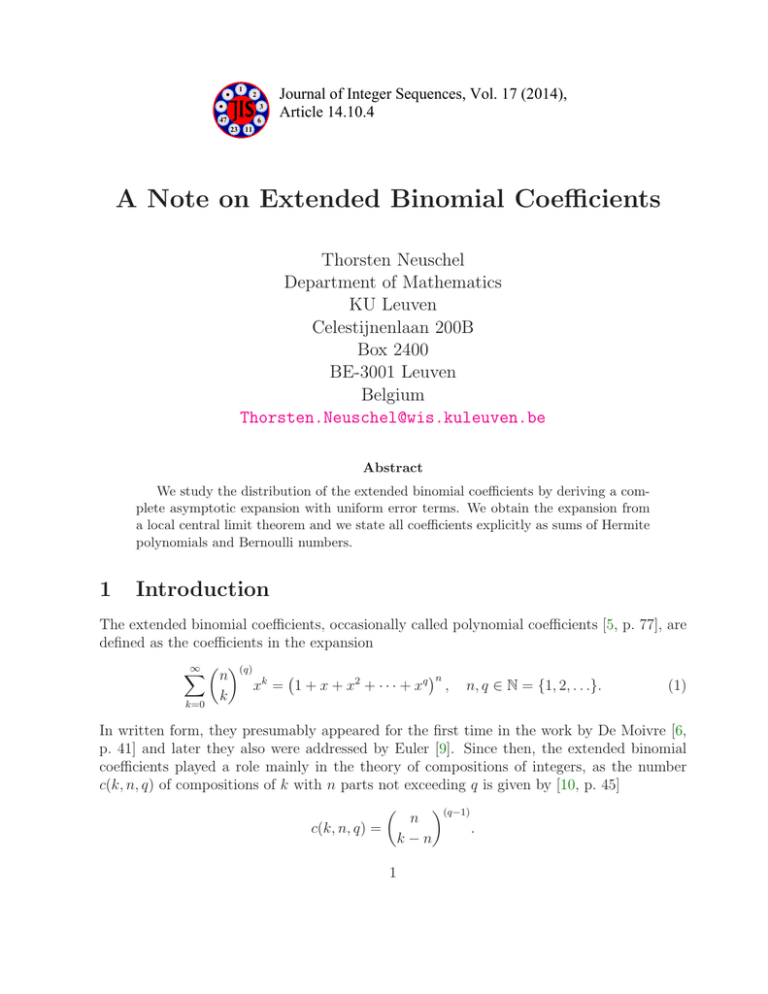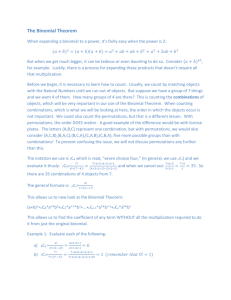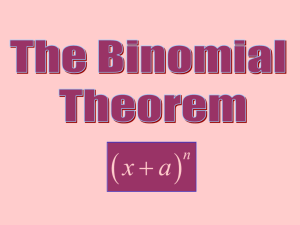A Note on Extended Binomial Coefficients Thorsten Neuschel Department of Mathematics KU Leuven
advertisement

1
2
3
47
6
Journal of Integer Sequences, Vol. 17 (2014),
Article 14.10.4
23 11
A Note on Extended Binomial Coefficients
Thorsten Neuschel
Department of Mathematics
KU Leuven
Celestijnenlaan 200B
Box 2400
BE-3001 Leuven
Belgium
Thorsten.Neuschel@wis.kuleuven.be
Abstract
We study the distribution of the extended binomial coefficients by deriving a complete asymptotic expansion with uniform error terms. We obtain the expansion from
a local central limit theorem and we state all coefficients explicitly as sums of Hermite
polynomials and Bernoulli numbers.
1
Introduction
The extended binomial coefficients, occasionally called polynomial coefficients [5, p. 77], are
defined as the coefficients in the expansion
∞ (q)
X
n
n
xk = 1 + x + x2 + · · · + xq , n, q ∈ N = {1, 2, . . .}.
(1)
k
k=0
In written form, they presumably appeared for the first time in the work by De Moivre [6,
p. 41] and later they also were addressed by Euler [9]. Since then, the extended binomial
coefficients played a role mainly in the theory of compositions of integers, as the number
c(k, n, q) of compositions of k with n parts not exceeding q is given by [10, p. 45]
(q−1)
n
.
c(k, n, q) =
k−n
1
Thus, the extended binomial coefficients and their modifications have been studied in various
papers and from different perspectives [1, 2, 3, 4, 7, 8, 12, 13, 15], and among the properties
their distribution is of particular interest. Recently, Eger [8] showed (using slightly different
notation) that
(q)
(q + 1)n
n
q
,
∼
nq/2
2πn q(q+2)
12
as n → ∞, meaning that the quotient of both sides tends to unity. Moreover, based upon
numerical simulations [8] the question arises how well those coefficients can be approximated
by “normal approximations” in general. It is the aim of this note to give a precise and
comprehensive answer to this question by establishing a complete asymptotic expansion for
the extended binomial coefficients with error terms holding uniformly with respect to all
integer k. More precisely, we show the following.
Theorem 1. For all integers N ≥ 2 we have
r
(q)
⌊(N −2)/2⌋
X q2ν (x)
q(q + 2)n
1 −x2 /2
n
1
1
=√ e
+
,
+o
12
(1 + q)n k
nν
n(N −2)/2
2π
ν=1
as n → ∞, uniformly with respect to all k ∈ Z, with
√
12
q x= p
k− n ,
2
q(q + 2)n
where the functions q2ν (x) are given explicitly as sums of Hermite polynomials and Bernoulli
numbers (see Theorem 5 below for the exact formulas).
Although we only deal with the very basic situation of the extended binomial coefficients
in (1) here, the presented approach is a general one, which admits the derivation of (complete)
asymptotic expansions in many applications. However, usually it is not possible to obtain the
involved quantities in a very explicit form, which is an instance making the case of extended
binomial coefficients especially interesting.
A general overview of the analytic theory of compositions can be found in Flajolet and
Sedgewick’s standard book [10], where essentially two asymptotic results on restricted com{1,...,q}
of compopositions are given [10, pp. 43–44]. The first one states that the numbers Ck
sitions of k with parts restricted to {1, . . . , q} asymptotically behave like
{1,...,q}
Ck
∼ cq ρ−k
q ,
as k → ∞, for fixed q ≥ 2. Here, cq > 0 is some constantand ρq is the singularity of the
associated generating function located in the interval 12 , 1 . The second result deals with
(n)
the number Ck of compositions of k having n parts. As these numbers are given explicitly
by
k−1
(n)
,
Ck =
n−1
2
we immediately obtain the asymptotic formula
(n)
Ck
k n−1
∼
,
(n − 1)!
as k → ∞, for fixed n. Interpreting the extended binomial coefficients as numbers of
restricted compositions, in the present paper we are concerned with the numbers c(k, n, q)
counting compositions of k with n parts restricted to {1, . . . , q}, which can be considered as
a mixed type of restricted compositions in the above sense. For fixed integer q, the result
in Theorem 5 gives a complete and explicit description of the behavior of c(k, n, q) for large
values of n, valid uniformly in k, meaning that with n growing to infinity it is not necessary
to specify the way k tends to infinity. This feature usually is not available by methods in
the context of singularity analysis.
2
Proof of the main result
Our approach is based on an application of a local central limit theorem. To this end, we
choose a sequence of independent random variables with common uniform distribution on
the integers {0, . . . , q}. This way, the extended binomial coefficients can be represented (up
to a normalization) as certain probabilities for the sums of the random variables. Before
stating the details, we will fix some notation following Petrov [14]. For a (real) random
variable X we denote its characteristic function by
ϕX (t) = EeitX ,
t ∈ R,
where, as usual, E means the mathematical expectation with respect to the underlying
probability distribution. If X has finite moments up to k-th order, then ϕX is k times
continuously differentiable on R and we have
1
dk
ϕX (t) = k EX k .
k
dt
i
t=0
Moreover, in this case we define the cumulants of order k by
1 dk
γk = k k log ϕX (t) ,
i dt
t=0
where the logarithm takes its principal branch. Now, let (Xn ) be a sequence of independent
integer-valued random variables having a common distribution and suppose that for all
positive integer values of k we have
E|X1 |k < ∞
and
EX1 = µ,
V arX1 = σ 2 > 0.
3
Thus, for the sum given by
n
X
Sn =
Xν
ν=1
we obtain
V arSn = nσ 2 ,
ESn = nµ,
and for integer k we define the probabilities
pn (k) = P (Sn = k) .
Furthermore, we introduce the Hermite polynomials (in the probabilist’s version)
Hm (x) = (−1)m ex
2 /2
dm −x2 /2
e
,
dxm
and for positive integers ν we define the functions
1
2
qν (x) = √ e−x /2
2π
X
Hν+2s (x)
ν
Y
m=1
k1 ,...,kν ≥0
k1 +2k2 +···+νkν =ν
1
km !
γm+2
(m + 2)!σ m+2
km
,
(2)
where s = k1 + · · · + kν and γm+2 denotes the cumulant of order m + 2 of X1 .
Finally, we demand (for convenience) that the maximal span of the distribution of X1
is equal to one. This means that there are no numbers a and h > 1 such that the values
taken on by X1 with probability one can be expressed in the form a + hk (k ∈ Z). Under
all these assumptions we have the following complete asymptotic expansion in the sense of
a local central limit theorem [14, p. 205].
Theorem 2. For all integers N ≥ 2 we have
N −2
√
X qν (x)
1
2
+o
σ npn (k) = √ e−x /2 +
nν/2
2π
ν=1
1
n(N −2)/2
,
(3)
as n → ∞, uniformly with respect to all k ∈ Z, where we have
x=
k − nµ
√ .
σ n
In the following we choose X1 to take the integer values {0, . . . , q} with
P (X1 = k) =
1
,
q+1
k ∈ {0, . . . , q}.
Hence, we obtain
(q)
1
n
pn (k) = P (Sn = k) =
, k ∈ Z.
(4)
n
(1 + q) k
It is our aim to apply Theorem 2 in full generality and we want to compute all cumulants
as explicitly as possible.
4
Lemma 3. For the k-th order cumulant γk of X1 we have
q
if k = 1;
2,
γk = 0,
if k odd and k > 1;
B2l
2l
(q + 1) − 1 , if k = 2l, l ≥ 1,
2l
(5)
where Bν , ν ≥ 0, denotes the Bernoulli numbers [11, p. 22].
Proof. First, we observe that the characteristic function of X1 is given by
ϕX1 (t) =
1 + eit + · · · + eqit
.
1+q
According to the definition of the cumulants we obtain for a positive integer k
1 dk
γk = k k log ϕX1 (t)
i dt
t=0
1 dk = k k log 1 + eit + · · · + eqit − log(1 + q) i dt
t=0
(q+1)it
k
1 d
e
−1 = k k log
it
i dt
e −1
t=0
!)
(
t
sin q+1
1 dk q
2
= k k
it + log
i dt
2
t=0
sin 2t
!
)
(
t sin
t
sin q+1
1 dk
q
2
2
− log
= δk,1 + k k log
,
t
q+1
2
i dt
t=0
t
2
2
where δk,1 denotes the Kronecker delta. Using
1
d
sin z
= cotan z −
log
dz
z
z
yields
1 dk−1
q
γk = δk,1 + k k−1
2
i dt
q+1
2
q+1
2
cotan
t−
2
(q + 1)t
1
−
2
t 2
cotan −
2 t
Now, making use of the following expansion [11, p. 35]
cotan z −
t=0
∞
1 X
4m
=
B2m z 2m−1 , 0 < |z| < π,
(−1)m
z m=1
(2m)!
after some algebra we obtain
∞
2m−1 q
1 dk−1 X
2m
m B2m
γk = δk,1 + k k−1
(q + 1) − 1 t
(−1)
.
2
i dt
(2m)!
t=0
m=1
Carrying out the differentiation under the summation sign immediately gives us (5).
5
.
Remark 4. As an immediate consequence of Lemma 3 we obtain
EX1 = µ = γ1 =
q
2
and, as we know B2 = 16 ,
V arX1 = σ 2 = γ2 =
q(q + 2)
B2
(q + 1)2 − 1 =
.
2
12
We now are ready to state the main theorem in form of a complete asymptotic expansion
(q)
with explicit coefficients for the extended binomial coefficients nk .
Theorem 5. For all integers N ≥ 2 we have
r
(q)
⌊(N −2)/2⌋
X q2ν (x)
n
1
1 −x2 /2
1
q(q + 2)n
+
,
+o
=√ e
ν
(N −2)/2
12
(1 + q)n k
n
n
2π
ν=1
as n → ∞, uniformly with respect to all k ∈ Z, with
√
q 12
x= p
k− n ,
2
q(q + 2)n
and
1
q2ν (x) = √
2π
X
×
12
q(q + 2)
ν
e−x
H2(ν+s) (x)
k2 ,k4 ,...,k2ν ≥0
k2 +2k4 +···+νk2ν =ν
2 /2
(6)
6
q(q + 2)
s Y
ν
m=1
1
k2m !
B2(m+1) ((q + 1)2m+2 − 1)
(2m + 2)!(m + 1)
k2m
,
where s = k2 + k4 + · · · + k2ν .
Proof. The proof is based on an application of Theorem 2 to the probabilities defined in (4).
First we observe that in our situation the functions given in (2) vanish identically for odd
indices, which turns out to be a consequence of (5). Indeed, if ν = 2l + 1 for an integer l ≥ 0,
then in every solution k1 , . . . , k2l+1 ≥ 0 of the equation
k1 + 2k2 + · · · + (2l + 1)k2l+1 = 2l + 1
there is at least one odd index i with ki > 0. Consequently, using (5) we have
2l+1
Y
m=1
1
km !
γm+2
(m + 2)!σ m+2
6
km
= 0,
from which follows that q2l+1 (x) vanishes identically. Thus, only the functions q2ν (x) appear
in (3) and here we have
1
2
q2ν (x) = √ e−x /2
2π
X
H2(ν+s) (x)
2ν
Y
m=1
k1 ,...,k2ν ≥0
k1 +2k2 +···+2νk2ν =2ν
1
km !
γm+2
(m + 2)!σ m+2
km
,
where s = k1 + · · · + k2ν . An analogous argument as in the odd case above shows that a
solution k1 , . . . , k2ν of the equation
k1 + 2k2 + · · · + 2νk2ν = 2ν
with a positive entry at an odd index does not give any contribution to the whole sum, so
that we can write
k2m
ν
X
Y
γ2m+2
1 −x2 /2
1
H2(ν+s) (x)
,
q2ν (x) = √ e
2m+2
k
!
(2m
+
2)!σ
2π
2m
k2 ,k4 ,...,k2ν ≥0
m=1
k2 +2k4 +···+νk2ν =ν
where s = k2 + k4 + · · · + k2ν . Now, taking the explicit form of the cumulants in (5) into
account, after some elementary computation we obtain (6).
For the purpose of illustration we state Theorem 5 for N = 5 explicitly.
Example 6. Using the known facts
H4 (x) = x4 − 6x2 + 3,
B4 = −
1
,
30
we obtain
r
(q)
q(q + 2)n
1 −x2 /2
((q + 1)4 − 1) (x4 − 6x2 + 3)
n
1
1
=√ e
1−
+o
,
12
(1 + q)n k
20nq 2 (q + 2)2
n3/2
2π
as n → ∞, uniformly with respect to all k ∈ Z, where we have
√
12
q x= p
k− n .
2
q(q + 2)n
3
Acknowledgments
The author would like to express his gratitude to two anonymous referees for their constructive comments improving the readability of the manuscript. This work is supported by KU
Leuven research grant OT/12/073 and the Belgian Interuniversity Attraction Pole P07/18.
7
References
[1] G. Andrews, Euler’s “Exemplum Memorabile Inductionis Fallacis” and q-trinomial coefficients, J. Amer. Math. Soc. 3 (1990), 653–669.
[2] N. Balakrishnan, K. Balasubramanian, and R. Viveros, Some discrete distributions
related to extended Pascal Triangles, Fibonacci Quart. 33 (1995), 415–425.
[3] C. Banderier and P. Hitczenko, Enumeration and asymptotics of restricted compositions
having the same number of parts, Discrete Appl. Math. 160 (2012), 2542–2554.
[4] C. Caiado and P. Rathie, Polynomial coefficients and distributions of the sum of discrete uniform variables, in A. Mathai, M. Pathan, K. Jose, J. Jacob, eds., Eighth Annual Conference of the Society of Special Functions and their Applications, Pala, India,
Society for Special Functions and their Applications, 2007. Available electronically at
http://community.dur.ac.uk/c.c.d.s.caiado/multinomial.pdf.
[5] L. Comtet, Advanced Combinatorics, D. Reidel Publishing Company, 1974.
[6] A. De Moivre, The Doctrine of Chances: or, A Method of Calculating the Probabilities
of Events in Play, 3rd ed. London: Millar, 1756; rpt. New York: Chelsea, 1967.
[7] S. Eger, Restricted weighted integer compositions and extended binomial coefficients,
J. Integer Seq. 16 (2013), Article 13.1.13.
[8] S. Eger, Stirling’s approximation for central extended binomial coefficients, Amer. Math.
Monthly 121 (2014), 344–349.
[9] L. Euler, De evolutione potestatis polynomialis cuiuscunque (1+x+x2 +x3 +x4 +etc.)n ,
Nova Acta Academiae Scientarum Imperialis Petropolitinae 12 (1801), 47–57.
[10] P. Flajolet and R. Sedgewick, Analytic Combinatorics, Cambridge University Press,
2009.
[11] I. Gradshteyn and I. Ryzhik, Table of Integrals, Series and Products, twelfth printing,
Academic Press, 1979.
[12] S. Heubach and T. Mansour, Compositions of n with parts in a set, Congr. Numer. 168
(2004), 127–143.
[13] A. Knopfmacher and B. Richmond, Compositions with distinct parts, Aequationes Math.
49 (1995), 86–97.
[14] V. Petrov, Sums of Independent Random Variables, Springer-Verlag, Berlin, 1975.
[15] Z. Star, An asymptotic formula in the theory of compositions, Aequationes Math. 13
(1975), 279–284.
8
2010 Mathematics Subject Classification: Primary 11P82; Secondary 05A16, 41A60.
Keywords: extended binomial coefficient, composition, restricted integer composition, complete asymptotic expansion, local central limit theorem, normal approximation, Hermite
polynomial, Bernoulli number.
(Concerned with sequences A002426, A005190, A008287, A027907, and A035343.)
Received July 29 2014; revised versions received October 1 2014; November 3 2014; November
4 2014. Published in Journal of Integer Sequences, November 4 2014.
Return to Journal of Integer Sequences home page.
9






